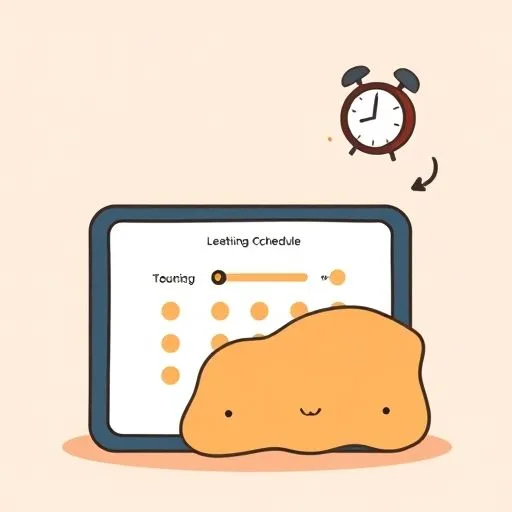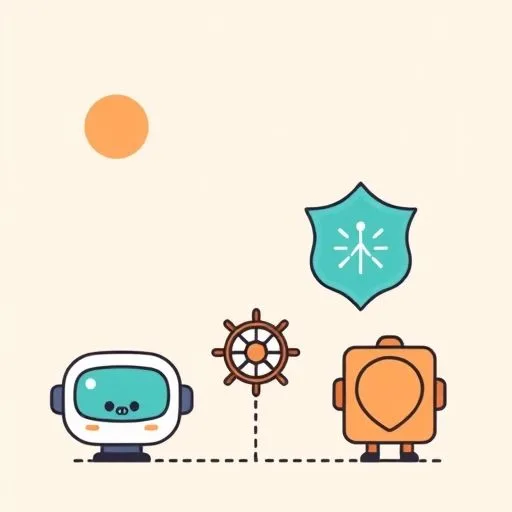
We know it’s 7:30 AM because the screen tells us—not the sunlight. But here’s what we’ve learned to trust: The way her hand touches the screen before sliding it toward the child, the way she says, ‘Let’s see… Yes, but maybe we’ll add a banana today. Just because we like it.’ A quiet strength, this—choosing between AI’s eating plan and her child’s hopeful eyes, then shaping the algorithm to fit his smile.
The AI Whisper Only We Know

These AI tools sound like they’re parenting us all now. We’ve all seen the bedtime reminders pop up on her phone—the same time every night, perfectly calibrated to optimal sleep schedules.
But what we don’t see? The way she subtracts 15 minutes when the screen glows, knowing the bedtime book needs to linger. That human touch.
AI makes it personal—the nutrition advice, the learning apps—but it’s a mother’s hand that redirects it. ‘We can try this veggie recipe it suggests,’ she’ll say, ‘but let’s add a little extra cheese—just like we did last Tuesday.’ That subtle adjustment.
Practical parenting tips start with a head nod to AI, but often end with a quiet glance at the child’s face. The point isn’t to fight what AI can do—it’s to let it hover, but not override the pulse of our home.
When the Algorithm Learns Your Child’s Laugh—But Not Their Fears

We’ve watched the kids’ faces light up talking to the smart speaker, haven’t we? They ask it anything—the weather, the exact height of volcanoes.
But that moment when her voice cuts through the room? A fundamental truth. ‘AI’s great at answers,’ you’ll hear her say, ‘but it’s never heard your scared imagination. The way you’re scared of shadows under the door. It doesn’t know that.’
That’s practical parenting. The AI can tell us how to keep kids safe online, but it doesn’t sense the fear in their voice when they ask unfamiliar questions.
That’s why we’ve learned to balance—the tool that’s helpful, the hand that’s essential. We don’t reject AI’s tailored suggestions… but we tuck the device into the pocket of the sweater she’d knit. And that’s the difference.
The ‘Real’ Family Dashboard—What We’ve Built Together

Our shared calendar is a digital rainbow of color-coded blocks. But the real family dashboard? The way she’ll pause, mid-swipe through the screen, and say, ‘Wait. This isn’t you right now. I know that face.’ That’s when the mom radar kicks in, huh?
That’s something no AI can ever replicate. Ever. It’s built on the data, but missing the heart. We’re not just managing the digital safety—it’s the emotional safety of a child’s world.
That’s the balance. We’ve leaned into the family-friendly AI solutions—but built our own quiet rules. The AI’s meal plan? The one that’s perfectly balanced? We’ll add a memory of the first time we made that recipe—the messy heart, the laughter.
We’re not just feeding the stomach—we’re feeding the family story.
Our Quietest Strength—What We Carry Without AI

AI’s amazing at helping. But it’s never felt the way a child’s hand digs into your sleeve when you help them. Never felt the pause.
The hidden strength—the way we hold the weight of the digital life, the family life, just the way parents hold their breath. We’ve got new tools, but the way she navigates—it’s the same: the way her hand on the child’s back, phone in the pocket, tells them ‘I’m here, but the screen can wait. You’re first.’
That’s something no AI can ever replicate. Ever. Those moments. The bedtime routine where the AI is set to play calming music—but she watches the screen’s timekeeping, and sighs, ‘Let’s skip the app tonight. I’ll sit with you.’
That’s the balance—the quiet menu of the human heart. AI can’t write that.
How to Build a Future They’ll Need—A Guide to Soft AI Parenting

1. Let the Machine Be the Assistant: AI isn’t the parent. It’s the assistant. Think of the way it’s helpful—but not the core. When the AI suggests meal plans, we’ll ask, ‘What do you think?’—letting the child’s voice shape the plan. The AI’s on the team—but not the captain.
2. Teach the Difference Between AI and Human Connection: We’ve learned to say, ‘We have to ask people—what do you think about that?’ when the kids rely on the device. The AI can’t feel the warmth—the way friends do. ‘We’ll ask the screen, but then we’ll ask each other.’
3. Hidden Safety Layers: We’re teaching the kids to ask, ‘Is this system safe? Should I share?’ We’ll look at the AI’s ideas, and then we think together, like a team. But practical parenting tips live in the conversation—weaving the AI suggestions into our family’s secret code.
4. When AI is Useful—But Not the Only Tool: We’ve got boundaries. We tell the kids, ‘We’ll use the AI to help with homework—but we’ll also talk about why it’s important. And we’ll always have our own thoughts.’ The AI’s advice folds into the family’s rhythm—not replaces it.
5. Her Quiet Strength as the Guide: We’ve found that the best AI is the one that her hand adjusts. The way she’ll say, ‘That’s a good idea—but how about we try this?’ The way she’s not afraid of the tech, but uses it—like a tool—to build the family’s warmth.
And that’s the beautiful truth, isn’t it? We’re not just navigating screens and schedules—we’re building a legacy of love that no algorithm can ever capture. That quiet strength in her hand, that knowing glance across the room—that’s our family’s true north. And no matter how bright the screen glows, that light will always guide us home.
